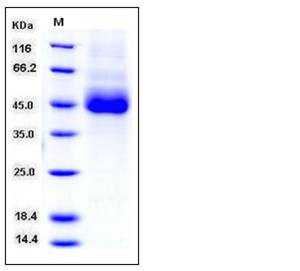Human CD1D / R3G1 Protein (His Tag)
CD1A,CD1D,MGC34622,R3
- 100ug (NPP3676) Please inquiry
| Catalog Number | P11009-H08H |
|---|---|
| Organism Species | Human |
| Host | Human Cells |
| Synonyms | CD1A,CD1D,MGC34622,R3 |
| Molecular Weight | The recombinant human CD1D consists of 293 amino acids and predicts a molecular mass of 33.3 kDa. As a result of glycosylation, rh CD1D migrates as an approximately 45-50 kDa band in SDS-PAGE under reducing conditions. |
| predicted N | Glu 20 |
| SDS-PAGE |  |
| Purity | > 88 % as determined by SDS-PAGE |
| Protein Construction | A DNA sequence encoding the extracellular domain of human CD1D (NP_001757.1) (Met 1-Ser 301) was expressed, with a C-terminal polyhistidine tag. |
| Bio-activity | |
| Research Area | Immunology |Adaptive Immunity |T Cell |T Cell CD Antigen |
| Formulation | Lyophilized from sterile PBS, pH 7.4 1. Normally 5 % - 8 % trehalose, mannitol and 0.01% Tween80 are added as protectants before lyophilization. Specific concentrations are included in the hardcopy of COA. |
| Background | The cluster of differentiation (CD) system is commonly used as cell markers in immunophynotyping. Different kinds of cells in the immune system can be identified through the surface CD molecules which associating with the immune function of the cell. There are more than 320 CD unique clusters and subclusters have been identified. Some of the CD molecules serve as receptors or ligands important to the cell through initiating a signal cascade which then alter the behavior of the cell. Some CD proteins do not take part in cell signal process but have other functions such as cell adhesion. Cluster of differentiation 1 (CD1) is a member of CD system. It's a family of glycoproteins expressed on the surface of various human antigen- presenting cells which are implicated in the presentation of lipid antigens to T-cells. Due to the different lipid anchoring, the CD1 family is classified into two groups: group1 (CD1a-c) and group2 (CD1d). CD1d with lipid antigens activate NK T-cells which rapidly produce Th1 and Th2 cytokines after been activated. |
| Reference |
